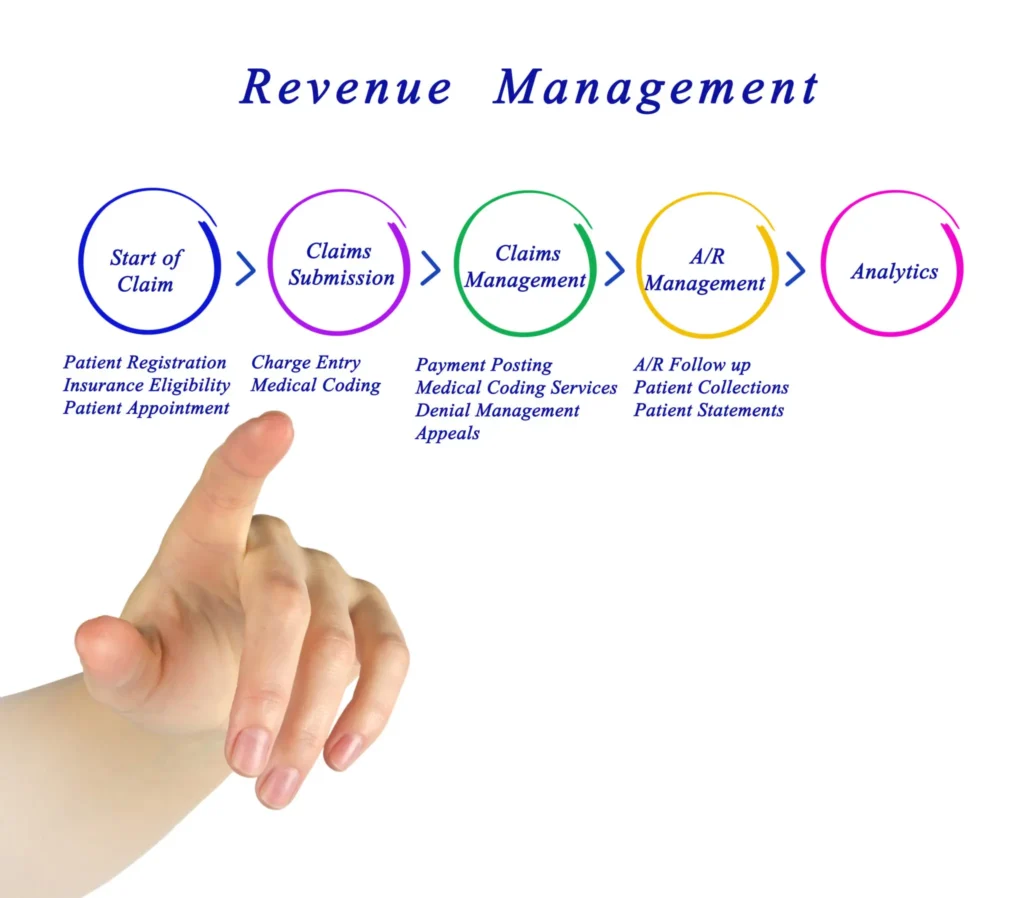
Revenue Cycle Management is the backbone of a financially sustainable practice. Running a healthcare practice is more than the provision of excellent patient care. It’s about making certain that your practice remains financially healthy. Even the most successful medical teams can face challenges when reimbursements are delayed, claims are backpedaled, or billing processes are insufficient.
These obstacles don’t just affect revenue. They can create administrative bottlenecks, staff frustration, and unnecessary stress for your patients. This is where Revenue Cycle Management (RCM) in medical billing becomes not just beneficial. But it is essential for your financial survival and growth.

What is Revenue Cycle Management (RCM) in Healthcare?
Revenue Cycle Management makes sure every service you provide is captured, billed, and reimbursed. It turns complex administrative work into a predictable and streamlined revenue flow
Revenue cycle Management in healthcare is the financial process that supports both clinical and administrative functions. Healthcare facilities use it to handle claims, payments, and revenue generation.
Traditional billing focuses mainly on claim submission and payment collection. RCM goes further. It covers the entire patient financial journey from pre-service to post-service follow-up.
The RCM process connects clinical data with administrative tasks. It simplifies billing and reduces errors. It also speeds up payments. Strong Revenue Cycle Management requires teamwork across departments.
Key stakeholders in the Revenue Cycle Management process include:
- Financial counselors to assist patients with payment options
- Revenue cycle analysts for monitoring performance metrics
- Patient access teams: responsible for registration and verification
- Clinical staff, to document services and capture charges
- Health information management professionals: to assign medical codes
- Medical Billing specialists, to submit and follow up on claims
It’s estimated that the U.S. healthcare industry loses up to $262 billion annually due to inefficient Revenue cycle management systems. The financial impact of effective RCM cannot be overstated.
Healthcare organizations with optimized revenue cycles typically see 15-30% improvement in collection rates. It also reduces days in accounts receivable and enhances cash flow predictability. (McKinsey Report)
The 12 Essential Steps of the Medical Billing RCM Process – Summary

- Patient Pre-Registration: First, collect patient demographics and insurance details before the appointment. Gathering scheduled information in advance prevents issues and improves efficiency.
- Insurance Eligibility Verification: Confirm active coverage and benefits. Check copays and deductibles using real-time systems.
- Patient Check-in & Registration: Update patient information at arrival. Collect copays. Complete required forms and consents.
- Charge Capture: Record all billable services. All procedures and supplies provided during the visit should also be recorded.
- Medical Coding: Translate clinical documentation into standardized ICD-10, CPT, and HCPCS codes for billing.
- Claims Submission: Prepare electronic claims with supporting documentation. Send accurate claims to insurance payers.
- Payment Posting: Record payments from insurers and patients. Apply them to the correct accounts.
- Insurance Follow-up: Tracks unpaid or partially paid claims and resolves issues delaying payment.
- Denial Management: Analyze rejected claims. Make corrections, then resubmit or file appeals.
- Patient Billing: Send clear statements of patient responsibility. Provide multiple payment options.
- Payment Collection: Manage outstanding balances. Set up payment plans. Send accounts to collections if needed.
- Reporting & Analysis: Monitor KPIs and revenue metrics. Identify weak points and improve the revenue cycle.
The Complete RCM Cycle in Medical Billing
The medical billing Revenue Cycle Management has three phases. Each phase contains critical steps that support accurate revenue capture and collection.
1. Pre-Service Phase
The pre-service phase is often the most critical part of the RCM cycle. Errors at this stage can affect the entire revenue process. They may cause claim denials. They may also result in payment delays and patient dissatisfaction.
Patient Registration and Eligibility Verification
This step requires collecting demographic details and insurance information. It involves verifying patient identity. It also confirms insurance coverage and benefits in real time. Advanced Revenue Cycle Management systems now connect with insurance databases. They provide instant eligibility verification. This reduces the risk of coverage-related claim denials.
Insurance Authorization and Pre-Certification
This step ensures that proposed services are included in the patient’s insurance plan. It confirms that required prior authorizations are obtained before service. It is crucial for high-cost procedures. It is also vital for specialist referrals and advanced imaging studies. If authorization is not obtained, the claim may be denied. This can result in large write-offs.
Financial Counseling and Estimate Provision
Financial counselors meet patients to explain insurance benefits. They provide estimates of out-of-pocket costs. They also present payment options. This proactive approach improves patient satisfaction. It also increases the chance of collecting patient portions at the time of service.
2. Service Phase: Accurate Capture and Documentation
The service phase focuses on capturing and documenting all billable services. This ensures that providers are paid correctly for the care they deliver.
Clinical Documentation and Charge Capture
Clinical documentation is the basis for all billing activities. Providers must record services clearly and accurately. Modern electronic health record systems include charge capture tools. These tools create billing charges based on documented services. This reduces the risk of missed charges. It also improves billing accuracy.
Medical Coding
Medical coding is one of the most technical parts of the RCM process. It requires knowledge of ICD-10 diagnosis codes. It also needs an understanding of CPT procedure codes and HCPCS supply codes. Accurate coding is essential for proper claim reimbursement. Wrong codes can cause denials. They can also reduce payments or create compliance risks. Our medical billing and medical coding team at Health & Billing is fully trained and certified. This ensures accuracy and compliance with all current rules.
Claim Preparation and Submission
This step requires compiling all relevant information. It includes patient demographics. It includes insurance details. It includes service codes and supporting documentation. All details are formatted into claims and sent to insurance payers.
3. Post-Service Phase: Collection and Resolution
The post-service phase ensures payments are collected. It resolves issues, so it helps to capture full revenue for services provided.
Payment Posting and Reconciliation
Payments from insurers and patients are matched with claims and invoices. The process identifies partial payments. It records adjustments. It flags discrepancies that need follow-up.
Denial Management and Appeals
This step handles rejected or denied claims. It uses analysis and resolution methods. It requires knowledge of common denial reasons. It also needs corrective actions to stop future denials. Appeals are filed when needed. Organizations with advanced denial management often achieve an 83% success rate on appealed claims.
Patient Billing and Collections
This step manages patient financial responsibility, including deductibles, copayments, and insurance. Modern billing focuses on transparency and offers clear communication. It also provides multiple payment options for patients.
Why Expert Revenue Cycle Management Services Are Crucial for Your Practice?
Expert and professional medical billing and RCM management are mandatory if you want to maximize the revenue of your practice. If professionally done, the Revenue Cycle Management process can:
- Ensures timely reimbursement from insurance companies and patients.
- Reduces claim denials and revenue leakage.
- Enhances financial visibility for better business decisions.
- Frees up your staff to focus on patient care rather than paperwork.
- Keeps your practice compliant with healthcare regulations.
- Scales with your practice as it grows and diversifies.
- Streamlines claims submission for faster payment cycles.
- Provides actionable reporting and analytics for strategic planning.
- Enhances patient satisfaction with clear, transparent billing.
- Offers expert handling of complex insurance and reimbursement processes.
- Reduces the risk of audits and financial penalties.
- Optimizes revenue flow across multiple specialties and services.
- Supports data-driven decisions with real-time financial insights.
At Health & Billing, our 100% HIPAA-Compliant experts professionally optimize each stage of your revenue cycle, so your practice thrives financially without compromising care quality.
Measuring RCM Success: Key Performance Indicators
Tracking the right KPIs of Revenue Cycle Management shows financial performance. It reduces revenue loss, thus improving patient satisfaction.
→ Days in A/R
Average time to collect payments. Benchmark is 30 to 50 days. Faster collections mean stronger cash flow.
→ Clean Claim Rate (CCR)
Percentage of claims submitted without errors. The industry standard is around 98%. High CCR reduces denials and speeds reimbursements.
→ Denial Rate
Percentage of rejected claims. AAPF suggests that the target is 5 to 10 percent or lower. Lower denials prevent revenue loss and reduce workload.
→ Net Collection Rate (NCR)
Percentage of expected revenue collected. The goal is 95% or higher. High NCR ensures maximum revenue capture.
→ Patient Satisfaction
Billing experience feedback from patients. Clear and smooth billing builds trust and loyalty.
→ Bad Debt Rate
Revenue lost due to unpaid balances. Lower bad debt protects profitability.
→ Cost to Collect
Expenses needed to collect each dollar. Efficient RCM reduces cost and raises net revenue. At Health & Billing, we help practices track and improve these KPIs. From reducing denials to increasing clean claim rates, we make sure your revenue cycle performs at its best.
Our Revenue Cycle Management Services
In-House Management
In-house Revenue Cycle Management gives direct control over processes. Staff are immediately accessible. Clinical operations may integrate better. Practices with large volumes may find this more cost-effective.
Outsourced RCM Services
Outsourced Revenue Cycle Management provides expert staff and advanced technology. It delivers cost advantages that smaller practices cannot achieve alone. Service providers usually offer complete solutions. These include patient access, coding, billing, denial management, and analytics. Outsourcing is useful for smaller practices or those without RCM expertise.
Hybrid Models
Hybrid models mix internal and external resources. For example, patient access may stay in-house. Coding and billing may be outsourced. This allows customization based on practice needs. At Health & Billing, we offer complete medical billing and RCM management.
Our specialty-focused approach strengthens every stage of the revenue cycle management and medical billing services in Florida and other states of the U.S. This helps practices thrive while maintaining quality care.
RCM Challenges and Solutions in Modern Healthcare
Key Challenges in the RCM Process
→ Incomplete or inaccurate patient information at registration can lead to claim rejections down the line.
→ Insurance verification delays slow down eligibility confirmation and cause payment disruptions.
→ Coding backlogs and errors increase the risk of denials and compliance issues.
→ Claim submission mistakes, from missing documentation to formatting errors, can delay reimbursements.
→ Patient collections difficulties, especially as patients shoulder more out-of-pocket costs, can negatively impact cash flow.
Each of these bottlenecks chips away at both revenue and efficiency, making it critical for practices to take a proactive, systematic approach.
Innovative Solutions to Drive Successful RCM Process!
Technology-driven tools: Artificial intelligence (AI) and machine learning (ML) can now predict claim denials, improve coding accuracy, and help prioritize collections.
Robotic process automation (RPA): Tasks like eligibility checks, payment posting, and claim tracking can be automated, reducing errors and freeing staff to focus on higher-value work.
Compliance readiness: With healthcare policies and payer requirements constantly evolving, staying compliant is vital. Ongoing training, audits, and policy monitoring help minimize risks.
Patient-focused billing: As patients take on more financial responsibility, practices must improve transparency and convenience.
Offering digital payment options, clear statements, and compassionate communication enhances patient satisfaction while improving collections.
Outsourcing expert, professional Revenue Cycle Management Services: By combining expert Revenue CcM management with modern technology and patient-centered strategies, practices can not only resolve current challenges but also build a stronger, more resilient revenue cycle.
At Health & Billing, we help healthcare practices of all sizes implement these solutions. We ensure smoother workflows, fewer denials, and more consistent revenue.
Bottom Line
Revenue Cycle Management in medical billing is a full strategy. It covers every step from the first patient visit to final payment. Practices that improve or outsource RCM gain stronger financial results. They also achieve smoother operations and higher patient satisfaction.
Revenue cycle management is not just about collecting money. It builds accurate and efficient systems. It protects revenue. It reduces costs. It ensures compliance. Best practices and modern tools are essential for success.
At Health & Billing, we partner with practices of every size. We cut denial and increase your collections. We maximize revenue while keeping the patient experience seamless.
FAQs
What does RCM stand for in medical billing?
RCM stands for Revenue Cycle Management in medical billing. It represents the comprehensive process associated with claims processing, payment collection, and revenue generation from patient registration through final payment.
How long does the RCM process take?
The complete Revenue cycle management process typically takes 15-120 days from service delivery to final payment collection, depending on factors such as:
- Insurance payer processing times (usually 14-30 days)
- Claim complexity and accuracy
- Prior authorization requirements
- Patient payment collection timeframes
- Any necessary appeals or corrections
What is the difference between medical billing and RCM?
Medical billing is a component of RCM that focuses specifically on claim submission and payment collection.
RCM is the broader process that includes:
- Pre-service activities (registration, eligibility verification)
- Clinical documentation and coding
- Medical billing and claims management
- Payment posting and reconciliation
- Denial management and appeals
- Patient financial counseling and collections
- Performance analytics and reporting
How can I improve my practice’s Revenue Cycle Management performance?
Key improvement strategies include:
- Implement real-time eligibility verification
- Train staff on proper documentation and coding
- Establish clear financial policies and patient communication
- Monitor KPIs regularly (days in A/R, denial rates, collection rates)
- Invest in automation technology for routine tasks
- Develop robust denial management processes
- Consider outsourcing specialized functions if lacking expertise
What is the ROI of investing in RCM improvements?
Organizations typically see ROI within 12-18 months through:
- Increased collections: 15-30% improvement in collection rates
- Reduced costs: 20-40% reduction in billing operational costs
- Faster payments: 25-50% reduction in days in A/R
- Fewer denials: 30-60% reduction in claim denial rates
- Improved compliance: Reduced risk of audits and penalties
- Better patient satisfaction: Enhanced financial experience









Comments are closed.